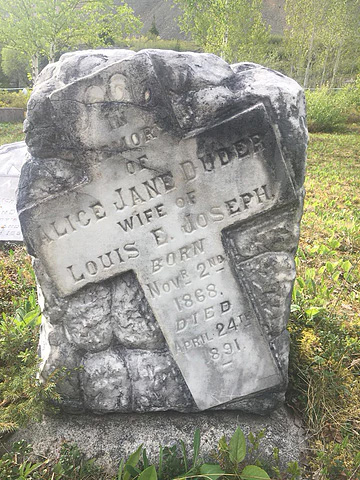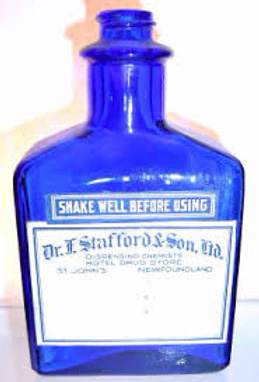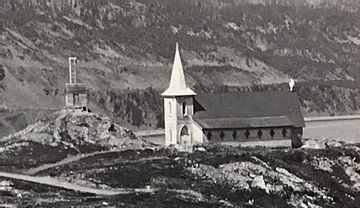 I should warn you that this starts with a grave. It’s only fitting, it’s a tragic story after all. There is a modest cemetery in The Bight where I’d walk, reading the names on the aging gravestones. That’s all they were to me then, just names. This was before the work began, before I knew the people behind those names, before I knew this story. Joseph stood out to me. It was an odd surname for Little Bay. I’d never heard of any Jospehs’ in town. I asked around but no one could tell me who they were. I was curious about them and how they’d come to rest there.
I should warn you that this starts with a grave. It’s only fitting, it’s a tragic story after all. There is a modest cemetery in The Bight where I’d walk, reading the names on the aging gravestones. That’s all they were to me then, just names. This was before the work began, before I knew the people behind those names, before I knew this story. Joseph stood out to me. It was an odd surname for Little Bay. I’d never heard of any Jospehs’ in town. I asked around but no one could tell me who they were. I was curious about them and how they’d come to rest there.
I would come to know Dr. Louis Eugene Jospeh as the third doctor employed at the Little Bay hospital. I have very few references to the Little Bay hospital but I know there was one which shared a building with the telegraph office by 1879. It hosted Little Bay’s first church service that year. In March 1887 the hospital was converted into a hall under the effort of Father Stephen O’Flynn and by January 1888 a new surgery was under construction in the town. I have the impression that there was a hospital in Little Bay almost immediately, one that was upgraded after the first decade. Its surgery was well supplied too as the Little Bay hospital was financed by the mine.
 The Little Bay hospital was first ran by Dr. Fredrick Linfield Rex Stafford. He was 22 when he arrived from Montreal where he’d attended McGill University. He personally was appointed by Baron Ellershausen. His practice was not limited to humans either as in 1881 he performed surgery on a swan. Dr. Stafford departed for Twillingate in 1883 and afterward started a chain of drugstores. They made their own remedies and ointments which became associated with Newfoundland’s identity and could be found in households across the island. It’s likely that he kept in contact with the town but I can’t say for certain if Dr. Jospeh ever met Dr. Stafford. Nevertheless, it was Dr. Stafford’s footsteps that Louis Jospeh found himself walking in and it’s likely that he supplied the town with Stafford’s medicines.
The Little Bay hospital was first ran by Dr. Fredrick Linfield Rex Stafford. He was 22 when he arrived from Montreal where he’d attended McGill University. He personally was appointed by Baron Ellershausen. His practice was not limited to humans either as in 1881 he performed surgery on a swan. Dr. Stafford departed for Twillingate in 1883 and afterward started a chain of drugstores. They made their own remedies and ointments which became associated with Newfoundland’s identity and could be found in households across the island. It’s likely that he kept in contact with the town but I can’t say for certain if Dr. Jospeh ever met Dr. Stafford. Nevertheless, it was Dr. Stafford’s footsteps that Louis Jospeh found himself walking in and it’s likely that he supplied the town with Stafford’s medicines.
 Dr. Jospeh certainly met Little Bay’s second doctor, Dr. David Henderson, who was in town from March 1883 until November 1884. Sergeant Wells’ diary makes reference to “the two doctors” attending one of his constables after a shooting in October 1884. I know Dr. Henderson was there for at least a month after Dr. Jospeh arrived. I imagine Dr. Henderson took the new doctor on a tour of the frontier facility that Dr. Stafford and the Baron had opened. They had a lot in common. Doctors’ Joseph and Henderson shared an interest in the town’s theatre culture – both performed in plays and performances at Little Bay’s Public Hall.
Dr. Jospeh certainly met Little Bay’s second doctor, Dr. David Henderson, who was in town from March 1883 until November 1884. Sergeant Wells’ diary makes reference to “the two doctors” attending one of his constables after a shooting in October 1884. I know Dr. Henderson was there for at least a month after Dr. Jospeh arrived. I imagine Dr. Henderson took the new doctor on a tour of the frontier facility that Dr. Stafford and the Baron had opened. They had a lot in common. Doctors’ Joseph and Henderson shared an interest in the town’s theatre culture – both performed in plays and performances at Little Bay’s Public Hall.
Dr. Louis Joseph had come all the way from Ceylon (modern day Sri Lanka), at the time a British colony, but not directly, he’d attended medical school first and graduated from the University of Aberdeen in 1884. That was the same year he arrived in Newfoundland, in the town where he would reside forever. The fresh faced and adventurous new doctor was 24 years old. I imagine him nervous and excited in this new world. The scene would be picturesque with the structures painted and tidy but the air would smell of sulphur from the smelters. The town would be quiet too with the miners underground during the day. It says something of the man that he undertook this journey. He’d traveled half way around the world to practice his trade in this prosperous and diverse new town. People came to Little Bay from many countries, they spoke several languages, and now a young doctor from Ceylon was welcomed into the mix.
In November 1884 the town celebrated his arrival and said goodbye to Dr. Henderson, who was returning home to Scotland. Posters were made and placed on telegraph poles and trees to announce a Public Hall event. The two doctors sat on stage alongside the other aristocracy including the visiting Dr. Stirling of Twillingate. A large crowd gathered to see them and they cheered three times for the departing Dr. Henderson and three more for their new doctor. Louis Joseph was home. I wonder how long it was before he realized that. I’d like to think it hit him immediately. Love at first sight. A cultured gentleman, he came from an upper class upbringing, well educated in literature and the arts. He took to the town’s highbrow culture with ease, regularly attending the Public Hall for musical performances and debates. He attended meetings at Little Bay’s Masonic Lodge and supplied the town’s Reading Room with an assortment of new articles and publications. It wasn’t long before he gave the public lectures on science and anatomy. His audiences were kept enthralled as he educated them with his reputable charm and great wit. They teased him about Adam’s missing rib when he explained the skeletal system and a reporter attending wrote of his good humour. Little Bay adored him.
 Under his watch they faced many challenges including outbreaks of diphtheria, smallpox, and measles. The measles outbreak required he oversee a boat quarantined in the harbour. Like today, not everyone listened to the advice of medical professionals and Constable Meany ignored Dr. Joseph’s quarantine putting the whole town at risk. Dr. Jospeh also regularly tended to wounds endured from the tragedies of mining, which resulted in broken bones and burns. He once amputated the lip of a man named Charles Phillips in order to save him from a tumour and he worked on one of the town’s policemen after a shooting. Together with Dr. Henderson they extracted a bullet from Constable Meany, saving his arm. In 1885 he secured smallpox vaccine for the community. Later that year he removed pieces of a broken jug from the head of Little Bay’s innkeeper “Big Dan” Courtney. In 1886 he even assessed the mental health of a man named David Drover who was believed to be insane.
Under his watch they faced many challenges including outbreaks of diphtheria, smallpox, and measles. The measles outbreak required he oversee a boat quarantined in the harbour. Like today, not everyone listened to the advice of medical professionals and Constable Meany ignored Dr. Joseph’s quarantine putting the whole town at risk. Dr. Jospeh also regularly tended to wounds endured from the tragedies of mining, which resulted in broken bones and burns. He once amputated the lip of a man named Charles Phillips in order to save him from a tumour and he worked on one of the town’s policemen after a shooting. Together with Dr. Henderson they extracted a bullet from Constable Meany, saving his arm. In 1885 he secured smallpox vaccine for the community. Later that year he removed pieces of a broken jug from the head of Little Bay’s innkeeper “Big Dan” Courtney. In 1886 he even assessed the mental health of a man named David Drover who was believed to be insane.
Little Bay was enamoured. He fell in love with the community in return. More particularly with a lovely young lady named Miss Alice Jane Duder. Voted one of the three most popular girls in town in 1885, she was the daughter of the sub collector for customs J.C. Duder. She’d caught his eye, no doubt, as he watched her sing on the stage there. They were married in the summer of 1889 by Rev. Arthur Pittman in St. Luke’s church on the hill overlooking the harbour. They were on top of the world together. There were over 200 people in attendance and wedding gifts arrived from around the globe. Fate would give them only two brief years together, however. I’d like to believe they were full years.
The grim disease of consumption followed. It killed much of the population at the time. That was just part of ordinary life then. We call it TB now. It would have started with a wet and persistent cough. I don’t know which of them showed symptoms first. His parents, Andries Adrianus and Carolina Amelia de Neys Joseph, rushed from Ceylon to bring him home, believing, as many did at the time, that the condition was a result of our damp climate. He refused to go. He could have but he didn’t. They said their last goodbyes and departed, returning to Ceylon without their son.
Dr. Joseph was home already, he’d found his home here at the edge of the world. He mattered to this place where civilization flourished under hardship and Little Bay mattered to him. He would see this journey to the end. Alice died first in the year of 1891. She was 22 years old. He joined her just two years later. They were buried next to each other in The Bight. The couple had no children. There was a touching write up about him and all he’d done for the community. Little Bay mourned for them, their popular foreign doctor and his beautiful young wife, so in love but so short lived. They’d gone too soon.
 It’s a sad tale. I did warn you. However, while researching him I found something more than the tragedy, I found a love story. Little Bay embraced Dr. Joseph and he loved the place right back. That love was personified in Alice. She was his Little Bay and he wouldn’t leave her. Even after she died he stayed by her side. He’s still there now, in the little cemetery in The Bight. I tried very hard to find a picture of this man, I even contacted his university in Scotland to no avail. Louis and Alice had no children so perhaps no pictures survived. I can tell you that his estate, known as Moi Mir, was managed by Postmaster Richard Walsh so maybe they ended up in the Walsh family. It’s nice to think of a faded photograph of him and Alice out there somewhere, maybe at their wedding together, happy still. They’re together now either way. If you’re ever in town I can take you to them. That’s where this started anyway.
It’s a sad tale. I did warn you. However, while researching him I found something more than the tragedy, I found a love story. Little Bay embraced Dr. Joseph and he loved the place right back. That love was personified in Alice. She was his Little Bay and he wouldn’t leave her. Even after she died he stayed by her side. He’s still there now, in the little cemetery in The Bight. I tried very hard to find a picture of this man, I even contacted his university in Scotland to no avail. Louis and Alice had no children so perhaps no pictures survived. I can tell you that his estate, known as Moi Mir, was managed by Postmaster Richard Walsh so maybe they ended up in the Walsh family. It’s nice to think of a faded photograph of him and Alice out there somewhere, maybe at their wedding together, happy still. They’re together now either way. If you’re ever in town I can take you to them. That’s where this started anyway.
It started at a grave.
Sources:
Sources for this piece are diverse. I’ve used information from the regular newspapers and diaries I often cite but this piece also drew from the British medical journals and the writing of Rev. Lumsden. I’ve also been in contact with several genealogists as well as the University of Aberdeen and Memorial University. Books on the history of Newfoundland medicine were consulted but only for information on Dr. Stafford. Further info on Stafford can be found on this site.
Thanks go to my friends David Hillier and Scott “Slayer” Quibell for their help in editing this piece.
If you’d like to donate to this project you can find my Pateron here.
Thanks for reading!

